

Volume 9, No. 2, Art. 51 – May 2008
Performative Research in Art Education: Scenes from the Seminar "Exploring Performative Rituals in City Space"1)
Ulrike Stutz
Abstract: In my contribution, I lay the foundations for a performative approach to art education research and then apply it to three examples from a performance seminar conducted with university students. In the process, I subject video documentaries produced during performative exploration of everyday rituals in public space, to a fresh performative analysis using media techniques. My research interest targets the reactions of passers-by as an expanded audience, i.e., it targets the qualitative changes of social space brought about by these actions of site specific art. The contribution is presented as a multimedia document with videos and animations. The parallel presentation of different media formats produces differentiating and activating readings.
Key words: site-specific art, art education, art history, aesthetic examination, video analysis
Table of Contents
1. Performative Research in Art Education
2. Performative Exploration of Everyday Rituals in City Space
3. Performative Qualitative Analyses
4. Performative Exploration of Rituals in City Space
4.1 "Directing"
4.1.1 Description of the performance
4.1.2 Performative video analysis
4.2 "Surveillance"
4.2.1 Description of the performance
4.2.2 Performative video analysis
5. Initiating Reflexive Spaces: Effects of the Site-specific Performances
1. Performative Research in Art Education
The relevance of Performative Social Research for art education is based on both scientific and educational reasons. From a social-scientific point of view, the relevance emerges from the changes in artistic praxis, which in contemporary art increasingly centres around the creation of situations in addition to the making of objects. This is evident in performance art and action art, as well as in social-space-related and participatory art forms like community art, new genre public art and site specific art. Media art—and in particular an inter-media praxis linking technology and physicality—produces specific forms of performative art (cf. ANGERER, 2001; KRÄMER, 2001; LEEKER, 1995, 2001). For art-related education and its didactics, these developments create new challenges, with regard to objectives and methods as well as to the reflection of pedagogically initiated situations. This also leads to a demand for research approaches corresponding to the processuality, body-relatedness and dramaturgy of these characteristically performative situations. [1]
The new orientation in art education should also be seen against the backdrop of currently emerging pedagogical theory, which makes productive use of the performative perspective (WULF & ZIRFAS, 2007; WULF et al., 2001; WULF & GÖHLICH & ZIRFAS, 2001). The importance of mimesis, interactivity, performativity, and of the materiality of performative action is being recognised, and the central question in art education is shifting from what to how. Similarly, the interest of art education research is shifting from output orientation to the construction and deconstruction of knowledge which is created within educational settings and organised in a physical-performative way. [2]
Performative ways of learning are already established in art education (STUTZ, 2008; LANGE, 2002; SOWA, 2000; SEITZ, 1999; PETERS, 1996). The discipline therefore offers special opportunities both for tracing the performative trend through art and pedagogy and for founding new research approaches. [3]
2. Performative Exploration of Everyday Rituals in City Space
In the following, I am going to analyse two performances using an approach that brings situations into focus through video recording. The performances under investigation were developed by students of Art Education during a seminar at the University of Duisberg-Essen. In the practical phase, students were instructed to observe actions and everyday performances in city space that indicate ritualised behaviour. Actions qualified as ritualised if they possessed both a meaning that went beyond pure functionality, and performative characteristics (cf. WULF, 2001, p.7). The two performances that I am going to describe and analyse are based on observations made on a market place and on a parking lot, both located in the city of Duisburg. [4]
Having first explored the sites as such, the students used their video recordings to analyse their observations in a performative way. In the process, they created performative interpretations that are more than a repetition of the perceived actions, but use abstraction, exaggeration, alienation, and decontextualisation to heighten meanings, thereby making them visible and accessible to reflection. This form of analysis employs methods of performance and site specific art (an artistic intervention that refers to the site where it takes place), which possess research characteristics themselves and provide finely developed methods of performative analysis and interpretation. [5]
3. Performative Qualitative Analyses
Performative research does not begin with the qualitative analysis of performances. In our example, the exploration of public space using video technology is itself a form of performative research. Instead of distanced observation, the researchers physically experienced the observed sites and actions and found themselves involved in the process. The same is true of the subsequent performative reflection, which required the researchers to experience the reactions to this provoking and irritating feedback. [6]
My qualitative analysis of the performances proceeds on two levels. The first level is their verbal description and interpretation in the text. On the second level, this text is hyperlinked to the video recordings under discussion. The videos are used both for documenting and for analysing the performances. The analysis proceeds through manipulation of the video material, such as alteration of speed and highlighting of details with graphic masks. The scenes under analysis were selected with the research interest in mind, i.e., to observe interactions between performers and passers-by and thus to learn about the effects the intervention has on the quality of social space. [7]
The methods of analysis I use here are based on the approach of reconstructive social research (BOHNSACK, 2003a), which attempts a comprehending reconstruction of social action (cf. MEUSER, 2003). [8]
With the re-performances described here, which were realised both in the students' performances and in the editing of their video recordings, this process of understanding unfolds not on a verbal-linguistic, but on a physical-aesthetic level. The re-performances thus allow us to generate insights that are not disconnected from but take place in connection with bodily and sensory experience. In the trajectory of Wolfgang WELSCH's (1995) term "aesthetic thinking", these insights can be described as "performative thinking". [9]
This method draws on methods for picture analysis which were developed in qualitative social research (EHRENSPECK & SCHÄFFER, 2003; BOHNSACK, 2003b, c) and particularly by researchers in art and media education (PEEZ, 2007, 2006, 2003; MAROTZKI & NIESYTO, 2006). I also put to use methods of picture interpretation from art history (IMDAHL, 1975, 1988; HUBER, 1989) and art education (OTTO & OTTO, 1987; CRIEGERN, 1999), which are applied especially in art education research (STUTZ 2008, 2007, 2006, 2004). [10]
In more concrete terms, the method described here is an extension of methods of picture analysis which, under the name of ästhetische Annäherung ("aesthetic approximation"), I have applied to non-moving pictures (STUTZ 2008, 2007, 2006, 2004). This approach uses aesthetic exploration achieved through reduction of form or colour not to clarify or illustrate a preceding verbal analysis, but to document the process of aesthetic exploration. In the process of comparative viewing, it also allows the viewers to generate aesthetically based insights themselves. Aesthetic approximation is based on insights from the psychology of perception, which have been formulated e.g. in gestalt theory (cf. ARNHEIM, 2000), as well as on methods of picture analysis developed in art history and art education following the turning away from copy theory (CRIEGERN, 1999; OTTO & OTTO, 1987). This allows for a better recognition, in the analytic process, of the independent, idiosyncratic rules of the visual. [11]
Referring to ARNHEIM's description of the picture-reading process, we can criticise PANOFSKY's (1932/1999) model for the interpretation of picture contents. which starts with the identification of details and progresses through the sequence of pre-iconographic, iconographic and iconological analysis. ARNHEIM inverted the sequence, proposing that the viewer first distinguishes fore- and background, perceiving the overall structure of the picture as a Vorgestalt ("pre-gestalt") (cf. ARNHEIM, 2000). Parallels to this "turn-around in the theory of perception" (p.48) are found in methods of picture analysis from art history, like IMDAHL's iconics. This method breaks picture analysis down into an analysis of pictorial layers: planimetric composition (the layout of the image area), perspective projection (spatial display of objects), and scenic choreography (presentation and position of persons in the picture). IMDAHL's iconics presumes a simultaneous process of perception and grants that a picture may contain not only homogeneous but also contradictory statements. With the graphic integration of dramatic choreographies into "meta-dramatic constructs", IMDAHL (1975) achieves a reduction of details that leads to the heightening of meanings on a visual level. [12]
In more recent art history, the picture-reading process is not described as simultaneous but as circular. For instance, the art historian Hans Dieter HUBER (1989) describes the interdependent processes that, starting with the first impression, take place from the perception of an overall structure—a Vorgestalt—through the exploration of detail to the construction of an Endgestalt. [13]
In action-oriented art education, the aesthetic examination of pictures, e.g. through graphic manipulation or the preparing of collections, makes it possible to create "percepts" that document the first impression (cf. OTTO & OTTO, 1987). In the concept by Gunter OTTO (1998, pp.195f.; OTTO & OTTO, 1987), this is the first step, later to be followed by the discovery of picture concepts as well as socio-cultural and historical contexts. Maria PETERS (1996), in contrast, approaches works of plastic art not through a sequence of steps, but in a complex manner, using performative methods as well as process-oriented writing methods. In her reconstructions of the gestures of plastic works, she achieves reduction of detail by slipping a flexible hose of white cloth over her body. [14]
Other forms of performative analysis can be found in disciplines that examine dance, and for which the question of how to capture and analyse fleeting body movements is highly pertinent. For instance, the digital documentation of dance movements made possible by FORSYTHE's (2003) Improvisation Technologies helps to form an "analytical eye". Using partially manipulated video recordings, this methods visualises traces of the dancer's body as it moves through space. [15]
The processes of discovery initiated by this approach of comprehending reconstruction are not reproductive but productive. The approach can be founded on the cognition theories of reception aesthetics, critique of representation and difference theory, as formulated by Wolfgang ISER (2002), Gilles DELEUZE (1997) and Jacques DERRIDA (1988, 2003). The generation of meaning can thus be described as a mimetic process taking place in the interplay of difference and repetition, a process that does not relate to transcendental points of reference but immanently creates them. To the development of research methods, this way of thinking makes available mimetic, performative methods in investigation and interpretation, which can be applied both as physical-bodily performance and through media like film and animation. [16]
Methods emerging from performative thinking are relevant for research both into art and art education. They provide adequate tools for an analysis of artistic processes that takes into account the complexity of these performative and aesthetic praxis forms. [17]
4. Performative Exploration of Rituals in City Space
4.1.1 Description of the performance
The performance Die Einweisung ("Directing") is based on the observation of the directing of vehicles into parking space. Because the driver is unable to fully see her or his manoeuvring space, the person who directs—often the front-seat passenger—controls the driver's driving with succinct gestures, and is thus placed in a dominant position. [18]
This functional action was first observed on a parking lot and then transferred by the students to different sites in public space. The sites included the side-walk in front of an advertising poster (see the video Directing 1 and Directing 2) and an escalator in a shopping mall (see the video Directing 3).
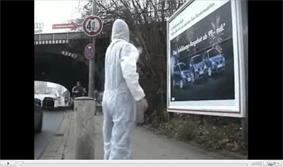
Video 1: Directing 1, please click here or on the picture to access/download the video.
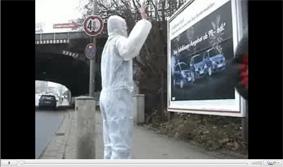
Video 2: Directing 2, please click here or on the picture to access/download the video.
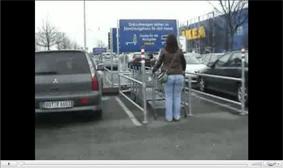
Video 3: Directing 3, please click here or on the picture to access/download the video. [19]
The performance of the functional action at other sites than where it was originally observed, leads to its decontextualisation and a shift in its meaning. The students added an element of abstraction in the form of the performer's clothing, a white overall, which gives the performance a meaning beyond actuality. The ritual character of the action was heightened by the repetition of one sequence of movement. [20]
The performance of directing in front of a car advertising poster, i.e., the direction of physical action at medial presentation, creates an absurd situation. The cars on the poster cannot move. Thus, the intention of directing them runs empty, and the dominant position assumed by the performer is unfounded. [21]
In the other variant of Directing, the performer targets shoppers with trolleys. They obey his gestures spontaneously and without asking questions. As a result, the usually casual and harmless action of parking a trolley is given an air of importance and danger, and the situation becomes ironical. The performer's dominant position seems exaggerated because the shoppers can see clearly where their trolleys are going and do not need his directions at all. [22]
4.1.2 Performative video analysis
The visual analysis of video recordings from both variants of the performance focuses on the reactions of passers-by. The irritating performance in front of the ad poster prompts passers-by to actively observe and reflect. Their everyday perception of public space is interrupted. One passer-by displays this by changing his step, stopping in front of the poster, and attentively studying the advertisement (see Directing 2). [23]
The documentation of the trolley variant shows that the commanding gestures of the performer make the shoppers obey in spite of the situations' surrealism (Directing 3). The interaction between performer and shopper synchronises their body movements. That one shopper grins into the camera as she walks away indicates that the shoppers attribute their participation in the performance to a second layer of reality, thus creating a distance between themselves and their actions. The perceptible presence of the camera is important for signalling the performance character of their actions and thus for establishing the second layer of experience. [24]
4.2.1 Description of the performance
In their performance Kontrolle ("Surveillance"), the students dealt with the ritual of security surveillance of public space. The site was a market place where traders offered their wares. With their video surveillance of the site, the students began by assuming the position of observers. Passers-by reacted to the students' activity, which they could not place at first, and in many cases people expressed their approval of the surveillance of the market. There developed a lively conversation with one passer-by, an elderly man who himself was charged with preventing illegal activities at the market. The actions observed in this man, like writing down notes, and his attitude towards the goings-on at the market were imitated and exaggerated by the students. [25]
There were two student performers, who used dress, posture, gestures and facial expressions as well as instruments to enact the surveillance, the effect of their performance being heightened by their elevated position. Their tense, unchanging postures express intense attention and set them off from the passers-by. The performers' facial expression is one of detachment. Their gestures, which in one case point into the crowd and in the other case are related to watching and observing, as well as the symbolic instruments of looking-glass and note pad, help to convey the act of surveillance. [26]
4.2.2 Performative video analysis
The visual analysis of the video recordings focuses on the interaction between the performers and the market visitors. [27]
The first thing that catches the eye is the seeming indifference displayed by passers-by towards the performers. In comparison, reactions towards the video camera are much more pronounced. Many passers-by acknowledge the presence of the camera with a glance, albeit from the corners of their eyes (see the video Control). Their expressions range from questioning over disapproval to amusement. Closer examination reveals that the acknowledgement of the camera's presence is in some cases accompanied by—sometimes only minimally—observation of the performers (see the video Control Slowmotion). Obviously, the performance and the video observation each create an irritation that passers-by try to resolve by relating both phenomena to each other. This is particularly well displayed the reaction of one man, who studies the performers from different angles and also looks into the camera (see the video Control Animation).
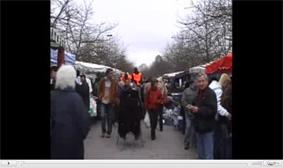
Video 4: Control, please click here or on the picture to access/download the video.
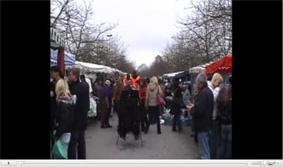
Video 5: Control Slowmotion, please click here or on the picture to access/download the video.
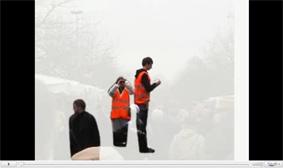
Video 6: Control Animation, please click here or on the picture to access/download the video. [28]
The perception of the video observation and thus of a medial layer enables passers-by to read the performance as a performance and not as a functional activity. The performance, which was based on the characteristics of the site itself and marked out as a performance, offered the option of experiencing the site as a reflexive public space. [29]
5. Initiating Reflexive Spaces: Effects of the Site-specific Performances
The performative video analysis highlighted several effects created by the performances:
The performances are perceived as irritating acts without functional objectives. When attention is directed at them, they interrupt everyday perception and prompt a more conscious and more differentiated perception of the site.
As derivatives of everyday actions, some of the performances invite interaction. These interactions are given a playful character if they are perceived as performance and thus attributed to a second layer of reality.
The obvious presence of an observer, which is associated with the video camera, is particularly helpful for the perception of performance as performance. This means that the observer's presence is a crucial factor for creating a reflexive space by way of a intervention-like performance, which thus also enables everyday actions to be seen as performance. [30]
To obtain an interpretation of these effects, we can refer to three possible strategies of the effectivity of art in public space (public art), which Boris GROYS (1998) mentions in his reflection on the Münster sculpture projects. One strategy is to make public art and its effects compete with its urban environment—an aesthetic method that, GROYS says, harbours the danger of the decorative. According to him, two other strategies relate to the site in more significant ways. One strategy uses artistic intervention to formulate a politico-social comment, thus visualising and commenting on the intervention's socio-spatial context. The third strategy, which GROYS (1998) sees as the most important one, sensibilises the viewers' eyes for their environment, i.e., it initiates a Blickmanipulation ("manipulation of the eye"). [31]
The third strategy seems particularly appropriate for the situations described in the present contribution. My analysis also makes it possible to point to the factors that support the "manipulation of the eye". Among them are the reference in the performance to site-related actions, and, importantly, the presence of video observation. The perceptible presence of video observation marks the performance as performance and thus contributes to increasing the autoreflexive quality of public space. [32]
Following Erika FISCHER-LICHTE's (2004) "aesthetics of the performative", the observed interactions may also be described as "role exchanges" (pp.63ff.) that modify relations between audience and actors during performances. FISCHER-LICHTE refers to an element of performances that from the 1960s onwards has become increasingly important in the performing arts. She identifies this element not only in explicitly invited participation of the audience, but also thinks that performances always constitute themselves in "feedback loops" (p.59) between audience and performers. The reason, she says, is the bodily co-presence of the two parties, who inevitably initiate interactions, albeit on the scale of micro-processes: "Where human beings meet, they react to each other, even if the fact remains imperceptible to eyes and ears" (p.67). [33]
These interactions unfold an especially strong reflexive dimension if they are based on conscious processes of perception initiating a break in habitual interpretations. This irritation-based perception makes observers refrain from automatically and unconsciously categorising the observed actions, but instead prompts them to experience themselves as perceivers and the perceived as perceived. FISCHER-LICHTE illustrates this process with the shifting of the observer's view in the perception of an actor on the stage. In one moment, the observer sees primarily the character in the play, and in the next he or she focuses on the actor's bodily presence. FISCHER-LICHTE (2004) calls this change of focus "perceptive multi-stability" (pp.255ff.). Vanguard performances since the 1960s, she says, have used strategies that potentiate this kind of perception by the audience. My study of performances in public space points out three different methods that serve this purpose: relating the performance to the context of the respective situation; exaggerating and decontextualising habitual actions; presence of video observation. The breaks created by means of these methods initiate reading processes that, in the sense of system theory, may be described as "second-order observation". These reading processes in their turn increase the part the audience plays in the joint production of the performance. [34]
According to FISCHER-LICHTE, even if a performance consciously aims to create discontinuities and to increase participativity and reflexivity, feedback loops are so unpredictable and uncontrollable that the effects even of a planned and practised performance are impossible to foresee. This openness constitutes an essential element of the communities within which performances take place. These communities are not institutionalised and permanent and thus not placed to develop power hierarchies. This kind of community formation also does not lead to collectivisation, but to a tension-filled conjunction of communality and individuality. The type of community formation FISCHER-LICHTE describes here is close to Hanna ARENDT's concept of the public. According to ARENDT (2002), the public is created through joint action of the multitude, i.e., by a process characterised not by homogeneity but by plurality and diversity creating a political space. [35]
FISCHER-LICHTE concludes that, in consideration of her concept of performances as interaction-based productions, dichotomies between the aesthetic, the social, and the political can no longer be maintained. All of them are dimensions of performance. Her aesthetics of the performative thus shifts the function of the aesthetic from simple representation to real action that changes social space. [36]
FISCHER-LICHTE's analysis of performative praxis makes it possible to place the observations exposed in the course of qualitative investigation in a theoretical context and to identify the significances of performative artistic praxis for improving the quality of social spaces. These significances are:
support for heterogeneous community formation as a social process which is especially important in the anonymity of large cities;
creation of reflexive experience spaces that allows the participants to become aware of processes of community formation;
sensibilisation of participants with regard to their own everyday actions and for the perception of their social environment, providing a basis for developing options of change. [37]
Both approach and results of my study show that forms of performative praxis are an important resource for research in the social sciences and art education. Researchers will profit from acquiring competences in this field. [38]
Experience with performative methods can help them, for instance, to recognise the significance of art in public space with regard to the development of social-space qualities in urban districts and to plan according interventions. Training in performative methods can help researchers to develop forms of cognition based on the body and the senses, and as a result to generate new research approaches. This is especially true for qualitative research, which always is a dialogue between researcher and the object under study (MAYRING 1996, pp.19ff.). Performative approaches can produce qualitative research methods that, reaching beyond the verbal and visual, initiate changes in social space even in the process of research. [39]
1) Translated by Philipp Pratap THAPA (philipp@thapa.de). <back>
Angerer, Marie-Luise (2001). I am suffering from a spatial hangover. Körpererfahrungen im NeuenMedienKunst-Kontext. In Peter Gendolla, Norbert M. Schmitz, Irmela Schneider & Peter M. Spangenberg (Eds.), Formen interaktiver Medienkunst (pp.166-182). Frankfurt/M.: Suhrkamp.
Arendt, Hannah (2002). Vita activa oder Vom tätigen Leben. München, Zürich: Piper.
Arnheim, Rudolf (2000). Kunst und Sehen. Eine Psychologie des schöpferischen Auges. Berlin: de Gruyter.
Bohnsack, Ralf (2003a). Rekonstruktive Sozialforschung (5th edition). Opladen: Leske+Budrich.
Bohnsack, Ralf (2003b). Qualitative Methoden der Bildinterpretation. Zeitschrift für Erziehungswissenschaft. 6 (2), 239-256.
Bohnsack, Ralf (2003c). Die dokumentarische Methode in der Bild- und Fotointerpretation. In Yvonne Ehrenspeck & Burkhard Schäffer (Eds.), Film- und Fotoanalyse in der Erziehungswissenschaft (pp.289-308). Opladen: Leske+Budrich.
Criegern, Axel von (1999). Konzepte künstlerischer Auseinandersetzung. Kunst und Unterricht, 233, 40-43
Deleuze, Gilles (1997). Differenz und Wiederholung. München: Fink.
Derrida, Jacques (1988). Signatur Ereignis Kontext. In Peter Engelmann (Ed.), Randgänge der Philosophie (pp.291-314). Wien: Passagen-Verlag.
Derrida, Jacques (2003). Eine gewisse unmögliche Möglichkeit, vom Ereignis zu sprechen. Berlin: Merve.
Ehrenspeck, Yvonne & Schäffer, Burkhard (2003). Film- und Fotoanalyse in der Erziehungswissenschaft. Opladen: Leske+Budrich.
Fischer-Lichte, Erika (2004). Ästhetik des Performativen. Frankfurt/M.: Suhrkamp.
Forsythe, William (2003). Improvisation technologies. A tool for the analytical dance eye (2nd edition). Ostfildern: Hatje und Cantz.
Groys, Boris (1998). Kunst am Bau—Eine Meinungsumfrage. In Markus Wailand & Vitus H. Weh (Eds.), Zur Sache Kunst am Bau (p.13). Wien: Triton.
Huber, Hans Dieter (1989). System und Wirkung. Rauschenberg-Twombly-Baruchello. München: Fink.
Imdahl, Max (1975). Wandel durch Nachahmung. Rembrandts Zeichnung nach Lastmans "Susanne im Bade". In Gerhard Hess (Ed.), Vorträge Kurt Badt zu Ehren (pp.19-38). Konstanz: Universitätsverlag.
Imdahl, Max (1988). Giotto—Arenafresken. Ikonographie—Ikonologie—Ikonik. München: Fink.
Iser, Wolfgang (2002). Mimesis und Performanz. In Uwe Wirth (Ed.), Performanz. Zwischen Sprachphilosophie und Kulturwissenschaften, (pp.243-261). Frankfurt/M.: Suhrkamp.
Krämer, Sybille (2001). Medien—Körper—Performance. Zwischen Person und "persona"—ein Gespräch. In Martina Leeker (Ed.), Maschinen, Medien, Performance. Theater an der Schnittstelle zu digitalen Welten (pp.471-479). Berlin: Alexander Verlag.
Lange, Marie-Luise (2002). Grenzüberschreitungen. Wege zur Performance. Königstein/Taunus: Ulrike Helmer Verlag.
Leeker, Martina (1995). Mime, Mimesis und Technologie. München: Fink.
Leeker, Martina (2001). Theater, Performance und technische Interaktion. Subjekte der Fremdheit. Im Spannungsgefüge von Datenkörper und Physis. In Peter Gendolla, Norbert M. Schmitz, Irmela Schneider & Peter M. Spangenberg (Eds.), Formen interaktiver Medienkunst (pp.265-290). Frankfurt a.M.: Suhrkamp.
Marotzki, Winfried & Niesyto, Horst (2006). Bildinterpretation und Bildverstehen. Wiesbaden: VS Verlag.
Mayring, Philipp (1996). Einführung in die qualitative Sozialforschung. Eine Anleitung zu qualitativem Denken. München: Beltz, Psychologie Verlags Union.
Meuser, Michael (2003). Rekonstruktive Sozialforschung. In Ralf Bohnsack, Winfried Marotzki & Michael Meuser (Eds.), Hauptbegriffe Qualitativer Sozialforschung (pp.140-142). Opladen: Leske+Budrich.
Otto, Gunter (1989). Das Methodenlabyrinth. In Gunter Otto (Ed.), Lehren und Lernen zwischen Didaktik und Ästhetik (pp.189-202). Seelze: Kallmeyer.
Otto, Gunter & Otto, Maria (1987). Auslegen. Ästhetische Erziehung als Praxis des Auslegens in Bildern und des Auslegens von Bildern. Seelze: Friedrich.
Panofsky, Erwin (1998/1932). Zum Problem der Beschreibung und Inhaltsdeutung von Werken der bildenden Kunst. In Karen Michels & Martin Warnke (Eds.), Erwin Panofsky. Deutschsprachige AufsätzeI, II (pp.1064-1077). Berlin: Akademie Verlag.
Peez, Georg (2003). Fotografien im Rahmen qualitativer kunstpädagogischer Forschung. In Yvonne Ehrenspeck & Burkhard Schäffer (Eds.), Film- und Fotoanalyse in der Erziehungswissenschaft (pp.289-308). Opladen: Leske+Budrich.
Peez, Georg (2006). Fotografien in pädagogischen Fallstudien. München: kopaed.
Peez, Georg (Ed.) (2007). Handbuch Fallforschung in der Ästhetischen Bildung / Kunstpädagogik. Baltmannsweiler: Schneider Verlag Hohengehren.
Peters, Maria (1996). Blick-Wort-Berührung. Differenzen als ästhetisches Potential in der Rezeption plastischer Werke von Arp-Maillol-F.E. Walther. München: Fink.
Seitz, Hanne (Ed.) (1999). Schreiben auf Wasser. Performative Verfahren in Kunst, Wissenschaft und Bildung. Essen: Klartext.
Sowa, Hubert (2000). Performanz—Szene—Lernsituation. Kunstpädagogik und Praxisparadigma. In Frank Schulz (Ed.), Prozesshafte Kunst im Unterrichtsprozess (Gelbe Reihe, 5) (pp.25-40). Universität Leipzig: Institut für Kunstpädagogik.
Stutz, Ulrike (2004). Ästhetische Annäherungen an Bilder in der qualitativen empirischen Forschung. MedienPädagogik, 1, http://www.medienpaed.com/ [Date of access: March 31, 2007].
Stutz, Ulrike (2006). Beteiligte Blicke—Ästhetische Annäherungen in qualitativen empirischen Untersuchungen. In Winfried Marotzki & Horst Niesyto (Eds.), Bildinterpretation und Bildverstehen (pp.143-174). Wiesbaden: VS-Verlag.
Stutz, Ulrike (2007). Erforschung performativer Dialoge in einer interkulturellen Begegnung. In Georg Peez (Ed.), Handbuch Fallforschung in der Ästhetischen Bildung / Kunstpädagogik (pp.45-55). Baltmannsweiler: Schneider Verlag Hohengehren.
Stutz, Ulrike (2008). Kommunikationsskulpturen. Entwurf einer sozialräumlichen kunstpädagogischen Praxis. Ästhetik —Theorie—Qualitative Empirie. München: kopaed.
Welsch, Wolfgang (1995). Ästhetisches Denken (4th edition). Stuttgart: Reclam.
Wulf, Christoph (2001). Einleitung. In Christoph Wulf, Birgit Althans, Kathrin Audehm, Constanze Bausch, Michael Göhlich, Stephan Sting, Anja Tervooren, Monika Wagner-Willi & Jörg Zirfas (Eds.), Das Soziale als Ritual (p.7). Opladen: Leske+Budrich.
Wulf, Christoph & Zirfas, Jörg (Eds.) (2007). Pädagogik des Performativen. Weinheim: Beltz.
Wulf, Christoph; Göhlich, Michael & Zirfas, Jörg (Eds.) (2001). Grundlagen des Performativen. Eine Einführung in die Zusammenhänge von Sprache, Macht und Handeln. Weinheim: Juventa.
Wulf, Christoph; Althans, Birgit; Audehm, Kathrin; Bausch, Constanze; Göhlich, Michael; Sting, Stephan; Tervooren, Anja; Wagner-Willi; Monika & Zirfas, Jörg (2001). Das Soziale als Ritual. Opladen: Leske+Budrich.
Dr. Ulrike STUTZ, Guest Professorship for Art Education at the TU Dresden
Contact:
Technische Universität Dresden
Institute for Art History and Musicology
August-Bebel-Straße 20
01219 Dresden
Germany
Tel.: +49 351 463 35703
E-mail: Ulrike.Stutz@tu-dresden.de, UlrikeStutz@web.de
URL:http://tu-dresden.de/die_tu_dresden/fakultaeten/philosophische_fakultaet/ikm/kupaed/personal/prof_kupaed, http://www.kunstforschung.net/
Stutz, Ulrike (2008). Performative Research in Art Education: Scenes from the Seminar "Exploring Performative Rituals in City Space" [36 paragraphs]. Forum Qualitative Sozialforschung / Forum: Qualitative Social Research, 9(2), Art. 51, https://doi.org/10.17169/fqs-9.2.411.
Revised 1/2023